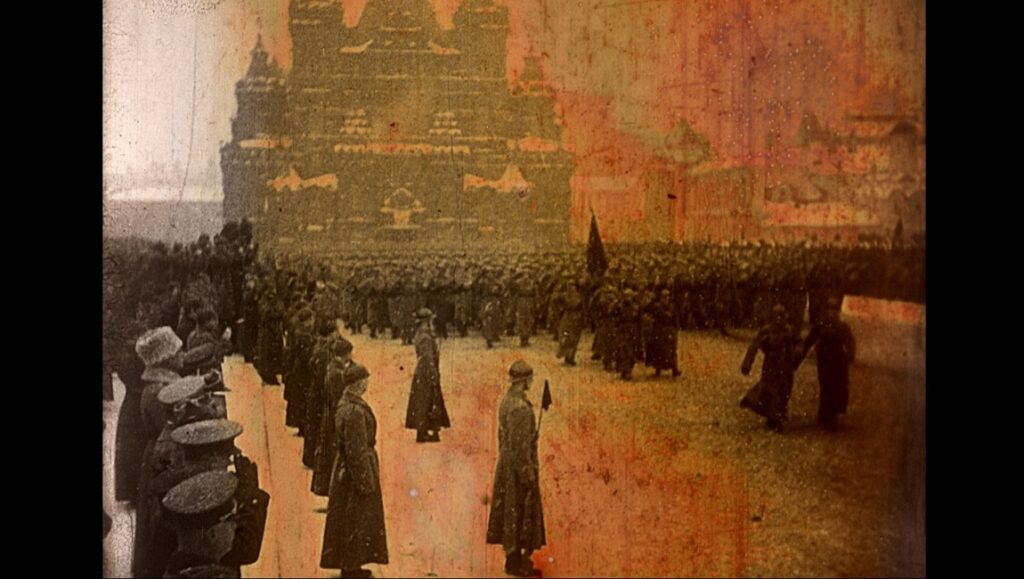The city of Bristol has a reputation which far proceeds itself. Known as a grungy site of resistance, from the Bristol Bus Boycott of 1963 all the way to 2020’s sinking of the statue of Edward Colston, the city’s cinema hub, The Watershed, offers a rather different site of resistance. It isn’t just that blockbuster fare is scorned by the cinema, but, through the repertory Cinema Rediscovered festival, film history is exhumed, re-autopsied, and occasionally burned.
At this year’s fifth edition of the festival, which featured 4K premieres of the likes of Lost Highway and Harold & Maude alongside 35mm prints of Fritz Lang’s Fury and Rouben Mamoulian’s Garbo joint Queen Christina, there was a prevailing interest in the notion of a film archive: what it is, what it could hold, and just who does the cataloguing anyway.
Hence, you have to program work by Bill Morrison. The feted visual artist’s films are noted for their tactile accessways into film history. In The Village Detective: A Song Cycle, he learns of an Icelandic fishing trawler that has pulled up four rolls of 35mm film. It’s a discovery worthy of any science fiction film, and as scored by David Lang’s striking accordion compositions — slow tones of sadness stretched to infinity — one feels haunted by the possibilities of what lurks beneath.
The first face we see is that of Soviet character actor Mikhail Zharov, who will probably be most recognizable to contemporary cinephiles as Skuratov, the right-hand man of Eistenstein’s Ivan the Terrible. His wrinkled but boyish features give him an Ernest Borgnine kind of charm, and Morrison would use him as a vessel to explore the USSR’s often hidden film history. But the rug is pulled. Soon, Morrison learns that the lost film canisters have spewed from a film that is not lost at all — The Village Detective (1968), a twee procedural which plays regularly on Russian television.
It’s difficult not to feel robbed, for a moment. Doesn’t the film’s abundance diminish the historical proportions of the project? The act of discovery is what made the likes of Morrison’s Dawson City: Frozen Time (2016) such a remarkable work. Instead of playing detective, then, the power of A Song Cycle comes through this minute movement. The fact of the find’s small scale gives the viewer focus on the material significance of each physical roll of film. How different versions give different experiences, have lived different lives.
Morrison articulates this through a simple juxtaposition of the film’s aspect ratio: when he plays digitally restored clips of the film, its presented in wide 1.78; the found reels themselves are in 4:3. They are water-damaged, creating a visual effect as though they were covered in muck and grime. But while these images are warped, they’re still half functional — stare at them long enough, and one can make out the movements of the actors almost as much as the stains of time. Stalin, too, lingers around the edges of the frame. Through this crumbling work we see the adjacently failing USSR. As much as Morrison reaches to prove the physical power of film, he doesn’t forget the phantasmagoric, “unseen” industrial engine of cinema.

While Morrison’s recurring notion is that time has frozen, Charlie Shackleton proves that time is melting with The Afterlight. This is another gimmick as film from the brew dog William Castle behind such stunts as Paint Drying — an 10 hour film intended to infuriate BBFC workers — and the equally tiresome Beyond Clueless video essay, which told viewers that actors in high school movies are hot, and the genre relies on regressive tropes.
The Afterlight is a supercut of gestures. Clips from films where actors are doing things: walking, talking, drinking, looking. Footsteps are the film’s metronome — if it doubt, cut back to a walk — but not it’s heartbeat. There’s no life here. The performers are all dead. Focus on what lives onscreen — waves, drinks, cigarettes. Some of the images are powerful, some are instantly recognizable, all are made benign by the limits of Shackleton’s research and reliance on the same kind of film. Primarily, he cribs from 1940s and 1950s noir, as well as British social films and a few Japanese classics.
Occasionally, the clips interact in interesting ways. Someone puts a record on, and it plays a whistling tune akin to the Whatsapp theme. Shackleton cuts around faces in thought, as though they all react to the tune. Once or twice, one line of dialogue matches another, but it never raises beyond the level of film grammar used in commercials. A single original shot, photographed by none other than Robbie Ryan, tracks toward a bar named The Afterlight. It’s aesthetically pleasing enough, but its real value comes from just how silly it is that the guy who shot Fish Tank would deign to waste his time on this lark. You either laugh or you’re out of the club.
Probably the most significant thing about the film is the print itself: The Afterlight only exists as a single 35mm print, which will presumably change as time progresses (perhaps it will be tossed into the Icelandic sea). As the print is under 18 months old, it still looks relatively pristine, so have we really seen what the film is meant to be? Its closing moments attempt to grapple with the extremities of changing time, by confronting Shackleton’s white gaze on film history. A clip of a black bartender — an extra — pauses, stretches, stands still. One barely has a moment to consider the ramifications of this ending, before the director swoops on stage to perform an obligatory Q+A, which culminates in his peddling of a sarcastic Afterlight t-shirt, and even stooping to read his bank account number for donations as a tragic, mock-self-deprecating move.

It’s all a very bizarre that someone so obviously accepted by the filmmaking establishment (BIFA award winner, regularly featured in The Guardian and Sight & Sound, did we mention Robbie Ryan?) still feels the need to sell himself as a maverick independent, particularly when the work itself is so vague and uninspiring. This is worth bringing up as the Q&A portion is essentially an inseparable part of the film. Shackleton owns the print and transports it himself, so a warning: to encounter the film almost guarantees being locked into watching his presentation of it too.
Irksome though it may be, Shackleton’s physical presence makes the case that it isn’t only documentary essay films that grapple with the notion of archive — it’s the festival layout itself. This year’s Cinema Rediscovered is adept at putting forward this argument. In its UK premiere, Zhang Yimou’s One Second makes a startling case for cinema as a physical object, specifically through a remarkable scene wherein a wise projectionist loops a film reel, creating a maze-life gif of the protagonist’s lost daughter, which he then climbs through as though Ethan Hunt navigating laserwire.
More impressive still is the entire strand “Women’s Stories from The Global South (& To Whom They Belong),” which includes films like De Cierta Manera (Sara Gómez, 1974), Araya (Margot Benacerraf, 1958), and Sambizanga (Sarah Maldoror, 1972). By programming these films at prime times, the festival managed to cultivate sold-out screenings of underseen titles, countering the tokenistic place that both films directed by women and those from the southern hemisphere often take in the European film festival. Arthouse cinema may often be a hierarchical and alienating space, but in its rigorous focus on the possibilities of archive, Cinema Rediscovered points to a hopeful future for film culture.


Comments are closed.